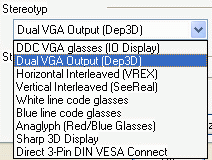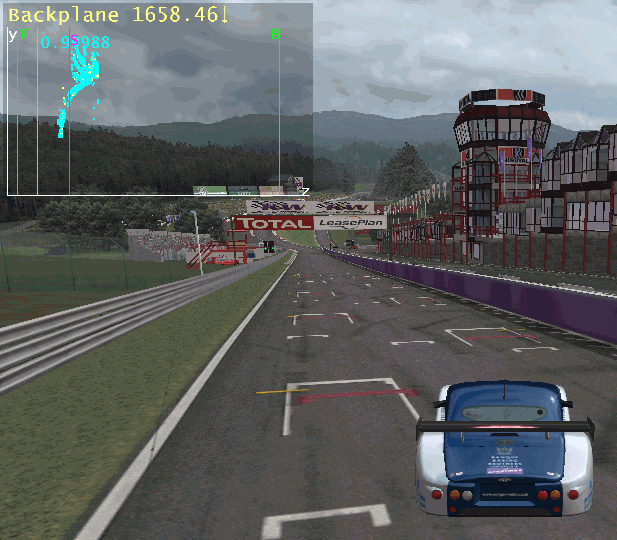
Inofficial nVIDIA stereoscopic3D driver page
This page was first released
on June 13, 2001
Last update: March 29, 2005
Current driver version:
71.84
Introduction
Download
Pro &
Con
How
to configure the nVidia stereo driver for your 3D-glasses, HMD, 3D-monitor
or 3D-projector:
How to activate
and use the OSD
How
to configure games which are not pre-defined by nVIDIA
How to use
ASUS glasses with the nVidia stereo driver
VGA-board
compatibility
Glasses-compatibility
nvidia
stereo profile editor
Forums
Introduction
nVidia decided to put stereo-capabilities to their reference drivers. NVidia based boards were already the best choice for gaming and amateur level stereo applications. With the reference stereo driver the gap between NVidia and it's competitors gets even wider. If you're interested in 3d-glasses and stereo-gaming a NVidia-based VGA-board is the logical choice.
The driver supports D3D and OpenGL games and full screen applications under Windows 95/98/Me/2000/XP and a variety of 3D-glasses (including red/blue cardboard glasses), projectors, HMD's and autostereo-monitors. The stereo driver comes with a stereo image viewer.
Download
At the nVIDIA site you'll find 3 files, which are required:
- the latest NVidia reference stereoscopic
driver
- the fitting NVidia reference graphics
driver (choose between 9x/Me or 2000/XP version)
- a huge manual for the driver
The version numbers of the graphics driver
and the stereo driver must match!
nVidia stereo reference driver Pro & Con
Pro
- Very good stereo quality
- Good game compatibility and stability
- Unusually good documentation
- Gigantic game settings library for virtually
all demos and full versions ever released (minus the latest ones)
- Medical and graphics mode tests
- Laser Sight stereoscopic aiming
- JPS full res stereo image viewer with
slide-show function
- Configurable hotkeys
- Supports wide range of stereo-hardware
Con
- Uses the same glasses-control-technology
as the ELSA Revelator driver at it's core - the DDC-trigger. This can cause
problems with certain monitors, 3D-sound drivers and digital input devices
on the game-port. This may very well be the fault of the likes of Microsoft
and Creative Labs, not necessarily the stereo-driver developers. Someone
doesn't play the rules of fair IRQ-usage.
- Hotkey and OSD problems
How to configure the nVidia stereo driver for your 3D-glasses, HMD, 3D-monitor or 3D-projector:
Activate selection for all stereo viewer types:

- Start the Windows Registry editor at
c:\windows\regedit.exe
- Choose: HKEY_LOCAL_MACHINE --> Software
--> NVidia Corp --> Global --> Stereo3D
- Select in the menu: edit -> new
-> DWORD
- Create new entry:
ShowAllViewerTypes
- Set dword to 1
How to activate and use preliminary stereo OSD (on screen display):

- Start the Windows Registry editor at
c:\windows\regedit.exe
- Choose: HKEY_LOCAL_MACHINE --> Software
--> NVidia Corp --> Global --> Stereo3D
- Select edit -> new -> DWORD
- Create new entry:
StereoOSDEnable
- Set DWORD to 1
The OSD will come up automatically when using any hotkey.
By disabling HW-T&L and HW-Vertex (in
the nvidia stereo compatibility
settings) the chance of making the OSD
work seem to increase. After
configuration you can return to normal
compatibility settings.
nVIDIA uses many synonyms for the
same thing in the display properties, the OSD
and the manual:
F = Frontplane = RHWgreater@screen
= screen depth = forward plane = Bildschirmtiefe
S = Screenplane = Convergence =
zero parallax = screen depth = Konvergenz
B = Backplane = RHWLesser@screen
= Hintergrund
Note that the term 'screen-depth' is used inconsistently.
If you are lucky you will see the following in the OSD:
A graph with y- and z-axis. The z-axis
is the depth. The left
side of the z-axis shows objects which
are closer to you - the viewer.
The right side shows objects farther from
you. Objects are depicted as
light-blue or yellow lines or dots. Often
there is a light-blue-line
on the left side which may represent the
'Minimum RHW
(depth information provided by the game)'
!? Often the game's HUD is located there.
There should also be green lines marked
as F and B for the frontplane
and backplane settings. The magenta line
marked S is for the
screenplane. All objects left of F will
have no parallax, they won't
be in stereo. The same applies for all
objects right of B. S - the
screenplane should be somewhere between
F and B. Objects between F and
S will come out of the screen, objects
between S and B will be inside
the screen. (Please also see
the diagram in the nVidia stereo manual -
71.84_ForceWare_3D_Stereo_Users_Guide.pdf.pdf,
figure 3.3, page 25 -
which explains the same facts.)
If the OSD won't work in a certain game
or if it doesn't give valid information,
you have to use the hot-keys blind. However
the logic remains the same.
So if you don't see the OSD, the OSD or
the diagram must be in your head.
Without this logic you won't know what
you're doing when using the hotkeys for F, S, B.
Often the value for F, S or B are far off
and you would have to hold the hotkey
forever to get decent values or
to get a depiction in the OSD (you may
see a F, S or B with an arrow
to left or right). In this case go to
the windows-registry and
manually define a decent value first.
You can use values from other
games or if one of the values (F, S or
B) is O.K. and/or visible in
the OSD use this value as a starting point
for the others.
How to configure games which are not pre-defined by nVIDIA
Don't get disheartened, configuration can be very tricky at first.
Read the nVIDIA stereo
manual 71.84_ForceWare_3D_Stereo_Users_Guide.pdf.pdf
This page is just meant as an add-on to
the official manual.
Check the forums and profile-editor-page for hints and pre-configuration-files.
You should reconfigure
the hotkeys. The default values fail in many
games. CTRL-X and
ALT-X hotkey combinations often collide with game-functions or
are disabled. I
had some good experiences with CTRL-ALT-X hotkey combinations.
Activate the OSD
via registry (see above). It will make using the
hotkeys much easier.
By saving your settings
via hotkey the original settings are overwritten,
even the values
given by nVidia for pre-configured games.
Make a backup of
the original nVidia settings with the
'nvidia
stereo profile editor' before you proceed.
By saving the values
of a game which isn't pre-defined by nVidia an
entry is made in
the windows-registry under the name of the game's exe-file.
However the game
will not show up under
'game-configuration'
in the nVidia display stereo properties, like the
pre-defined games.
One goal of configuring
a game is to bring the HUD (head up
display/on screen
info), like dashboard, scores, etc to the plane of the
screen (zero-parallax).
The HUD usually looks the best this way.
There are basically
two ways to achieve this: by F-hotkeys (frontplane setting) -
and/or S-hotkeys
(screenplane setting). I'd prefer to do it by frontplane setting,
because this way
you keep the freedom of configuring the screenplane
setting freely to
achieve the best stereo effect and the best balance
between inside-
and out-of-screen-effects. This technique is
suitable if no objects
are closer to the viewer than the HUD. If, for
example, in a racing
game your car is closer or at the same level as
the HUD and you
use the frontplane-setting to kill stereo for these
front objects your
car will also become flat. If that's the case use
the S-screenplane-setting
to achieve flatness (zero-parallax) for the
HUD. Unfortunately
the F-frontplane and B-backplane hotkeys don't seem to work.
Anyway the main goal
is to get good, meaningful stereo, which means a true distinction
between close and
far objects. Sometimes the HUD has to be sacrificed completely
in order to get
good stereo.
Another goal is to
prevent the backdrop/sky/horizon from sticking out. Usually this can't
be fixed. You should
check however if the backplane is set correctly. In some
games the problem
can be fixed by bringing the 'B-backplane-setting' behind the horizon.
How to use ASUS glasses with the nVidia stereo driver
In order to use ASUS-glasses (onboard or VR100-upgrade kit) with the latest nVIDIA stereo driver (71.84) follow the instructions above to make all stereo viewer types visible in the setup. Then choose 'Direct 3-Pin VESA connector'. There seems to be no more ASUS mode. There is no control to achieve correct stereo-left-right-orientation by default with ASUS glasses. You may experience inversed stereo (right eye sees left image and vice versa), which must be avoided! Use the stereo on-off-hotkey until the orientation is correct (left eye sees image dedicated for left and vice versa).
ASUS Deluxe VGA boards - modified onboard glasses-controller design
Certain models of the ASUS Deluxe-line of nVidia based VGA-boards featured an on-board shutterglasses-controller. In the past (at least up to model V6600) the controller was always active, making it possible to use 3rd party drivers. In the newer design (at least since model V84x0) the controller is usually inactive. Use the 'Direct-3-Pin VESA connector'-mode as described above to activate the glasses. Take care not to use inversed stereo. The latest ASUS deluxe models doesn't seem to have the stereo-connector anymore.
Hint: If you use VGA-port 2 on V8xxx deluxe dual VGA ASUS boards the glasses will be always on, just like on older models.
If you have some spare ASUS-glasses with no controller and no ASUS-deluxe VGA-board to plug them into you can't use them. Apart from buying a controller, which may be difficult, you can build one.
VGA-board compatibility:
all nVIDIA based boards with chipsets from the TNT-, GeForce- or Quadro-familiy
3D-glasses compatibility:
Glasses which are fully supported with
automatic stereo-orientation and automatic on/off:
- X3D, eDimensional, ELSA Revelator, i-glasses-H3D-Cruiser, i-glasses-H3D-Gamer, latest Cybervision models
Glasses which are fully supported
with automatic stereo-orientation:
- miro 3D-fanatix, StereoGraphics SimulEyes, CrystalEyes2 with EPC-controller, CrystalEyes3, StereoEyes (use blue or white line code mode)
Glasses supported with manual stereo-orientation
(make
shure you choose the right stereo-orientation to avoid inverted stereo):
- All i-Art glasses models (except Eye3D-PCI), all VRStandard VR-Joy models, all AnotherWorld models, all CyberVision models, all Tetratel models, all APEC-models with VGA-interface, NuVision 60GX-NSR
Glasses which are not (fully) supported:
- ASUS onboard and upgrade glasses controller - see above
- i-Art Eye3D PCI: You can activate the Eye3D-PCI using the Eye3D-Activator, but within a game you usually can't use the hotkey for stereo-reverse. The NVidia driver has no reverse hotkey so your only chance may be to use the 3D-on/off hotkey until you get the right stereo-orientation by chance
- Glasses with serial or parallel port interface (i.e. 3D-Spex, Cyberboy, etc.): the driver doesn't send a trigger signal to the serial or parallel port. You may try to get it work using the WINx3D driver or build a homebrew VGA-interface for your glasses.
- Classic H3D/Wicked3D glasses: some problems - you need H3D-Activator to switch on the glasses. You can try page-flipping or line-blanking mode, but refresh rate may be limited. Stereo orientation is a real problem. Often you will end up with inversed stereo. In page-flipping mode you can use the stereo on/off-hotkey of the nVidia driver as long as you catch the right orientation.
Editor
Check out the 'nvidia stereo profile editor' by Mikael Gustafsson. It allows you to edit and save nvidia stereo driver registry settings. On the site you can share (upload, download) and rate stereo settings for every game.
Forums
For discussing the driver please join the following webboards:
stereo3d.com Discussion
Board
Stereovision.net
Forum
nVIDIA
ForceWare Forum
Brand and product names are trademarks or registered trademarks of their
respective holders.
The author doesn't guarantee the accuracy of the information given on this
page.
The text and images
on this page are the intellectual property of the author.
Don't copy any part
of it without credit and link to this site!
